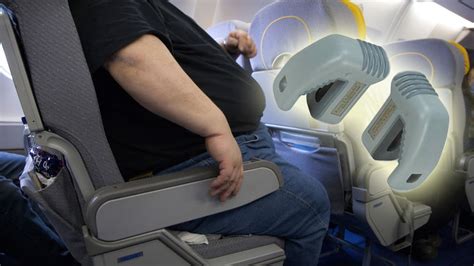
Rude behavior on airplanes could now lead to significant financial penalties, as the Federal Aviation Administration (FAA) steps up its enforcement against unruly passengers, potentially issuing fines up to $37,000 per violation. The FAA’s zero-tolerance policy, initially implemented during the height of pandemic-related mask mandates, remains in effect, targeting a range of disruptive actions that threaten the safety and comfort of passengers and crew.
The FAA has made it clear that actions considered disruptive and subject to penalties include, but are not limited to, interfering with crew members, physical or verbal assault, and refusing to follow instructions. This crackdown comes in response to a surge in reported incidents of air rage, prompting the agency to take a more aggressive stance against such behavior. The consequences of violating these rules can be severe, extending beyond monetary fines to include potential criminal charges and being banned from flying with certain airlines.
FAA’s Zero-Tolerance Policy and Increased Penalties
The FAA’s zero-tolerance policy significantly lowers the threshold for taking action against unruly passengers. Historically, airlines addressed disruptive behavior primarily through warnings and, in more extreme cases, by deplaning passengers or refusing them future travel. However, the surge in incidents over the past few years prompted a more immediate and stringent response.
Under the zero-tolerance policy, the FAA can bypass the typical warning process and immediately propose fines or pursue legal action against passengers who engage in disruptive behavior. “The FAA has zero tolerance for unruly behavior,” the agency stated, emphasizing its commitment to ensuring safety and order in the skies. The policy empowers the FAA to impose substantial civil penalties, which can reach up to $37,000 per violation. For instance, the FAA has proposed fines ranging from a few thousand dollars to tens of thousands of dollars for incidents involving passengers who physically assaulted crew members, consumed alcohol not served by the airline, or refused to wear masks when required.
The increased penalties serve as a deterrent, aiming to discourage passengers from engaging in behaviors that could compromise the safety and comfort of others. The FAA hopes that the threat of significant financial consequences will lead to a reduction in incidents of air rage and a more respectful environment for both passengers and crew.
Defining Disruptive Behavior: What Constitutes a Violation?
Understanding what constitutes disruptive behavior is crucial for passengers to avoid inadvertently violating FAA regulations. Disruptive behavior encompasses a wide range of actions that can jeopardize the safety and well-being of those on board an aircraft. These behaviors include, but are not limited to:
- Interfering with Crew Members: Any action that obstructs or hinders the performance of a crew member’s duties is considered a violation. This can include verbal harassment, physical assault, or any other form of intimidation that disrupts the crew’s ability to manage the flight safely.
- Physical or Verbal Assault: Physical violence, threats, or any form of abusive language directed at passengers or crew members is strictly prohibited. Such behavior creates a hostile environment and can lead to further escalation of conflict.
- Refusing to Follow Instructions: Passengers are required to comply with lawful instructions given by the crew, including those related to safety regulations, such as wearing seatbelts, stowing carry-on luggage, and refraining from using electronic devices during takeoff and landing.
- Consuming Alcohol Not Served by the Airline: Regulations prohibit passengers from consuming alcoholic beverages that have not been served by the airline. This is to ensure that the crew can monitor alcohol consumption and prevent intoxication that could lead to disruptive behavior.
- Tampering with Aircraft Equipment: Any attempt to tamper with or damage aircraft equipment, including lavatory smoke detectors, is considered a serious offense that can endanger the safety of the flight.
- Making Threats or False Statements: Threatening to harm passengers or crew members, or making false statements that could cause alarm or panic, are considered disruptive behaviors that can result in severe penalties.
- Smoking in Prohibited Areas: Smoking is prohibited in all areas of commercial aircraft, including lavatories. Violators may face fines and other penalties.
Impact on Passengers and Crew
The increase in air rage incidents has had a significant impact on both passengers and crew members. Passengers have reported feeling anxious and unsafe on flights due to the presence of disruptive individuals. Flight attendants, who are often the first line of defense in managing unruly passengers, have faced increased levels of stress and even physical assault.
According to a survey conducted by the Association of Flight Attendants-CWA (AFA), a significant percentage of flight attendants have experienced or witnessed incidents of unruly passenger behavior. The survey revealed that many flight attendants have been verbally harassed, physically assaulted, or threatened by passengers.
The FAA’s crackdown on disruptive behavior is intended to create a safer and more respectful environment for both passengers and crew members. By imposing stricter penalties and enforcing regulations more aggressively, the agency aims to deter disruptive behavior and ensure that flights are conducted in a safe and orderly manner.
Factors Contributing to Air Rage
Several factors have been identified as contributing to the rise in air rage incidents. These include:
- Stress and Anxiety: Air travel can be a stressful experience for many people, particularly those who are anxious about flying or unfamiliar with airport procedures. Stress and anxiety can lead to increased irritability and a lower tolerance for perceived inconveniences.
- Alcohol Consumption: Alcohol can impair judgment and lower inhibitions, making individuals more likely to engage in disruptive behavior. Passengers who consume excessive amounts of alcohol before or during a flight may become aggressive or uncooperative.
- Mask Mandates and COVID-19 Related Restrictions: The COVID-19 pandemic and related mask mandates created additional stress and tension among passengers. Some individuals resisted mask requirements, leading to conflicts with crew members and other passengers. While most mask mandates have been lifted, residual frustration and anxiety related to the pandemic may still contribute to disruptive behavior.
- Reduced Legroom and Increased Passenger Density: Overcrowded flights and reduced legroom can contribute to discomfort and frustration, increasing the likelihood of conflict among passengers. Airlines have been criticized for prioritizing profits over passenger comfort, leading to a more stressful flying experience.
- Socioeconomic Factors: A study published in the Journal of Air Transport Management suggested that socioeconomic factors may play a role in air rage incidents. The study found a correlation between economic inequality and disruptive passenger behavior, suggesting that individuals from lower socioeconomic backgrounds may be more likely to act out on flights.
Legal and Regulatory Framework
The legal and regulatory framework governing passenger behavior on aircraft is established by the FAA and international aviation authorities. The FAA’s regulations prohibit any action that could endanger the safety of the aircraft or the well-being of passengers and crew.
Under federal law, interfering with a flight crew member is a felony offense that can result in imprisonment and substantial fines. The FAA has the authority to investigate and prosecute individuals who violate these regulations.
In addition to federal laws, airlines have their own rules and policies regarding passenger behavior. Passengers who violate these rules may be subject to penalties, including being banned from flying with the airline in the future.
International aviation agreements, such as the Montreal Protocol, also address passenger behavior on international flights. These agreements provide a framework for cooperation among countries in addressing incidents of air rage and ensuring the safety of air travel.
How to Avoid Being Fined or Penalized
To avoid being fined or penalized for disruptive behavior on an airplane, passengers should adhere to the following guidelines:
- Follow Crew Instructions: Always comply with lawful instructions given by the crew, including those related to safety regulations and emergency procedures.
- Be Respectful to Passengers and Crew: Treat fellow passengers and crew members with courtesy and respect. Avoid engaging in aggressive or confrontational behavior.
- Control Alcohol Consumption: Limit alcohol consumption before and during flights. If you choose to drink, do so responsibly and be aware of your limits.
- Manage Stress and Anxiety: If you are anxious about flying, take steps to manage your stress and anxiety before and during the flight. This may include practicing relaxation techniques, listening to calming music, or talking to a therapist.
- Report Concerns to Crew: If you have concerns about the behavior of another passenger, report them to a crew member. Do not attempt to intervene or confront the individual yourself.
- Be Aware of Airline Policies: Familiarize yourself with the airline’s policies regarding passenger behavior. These policies are typically outlined in the airline’s terms and conditions of carriage.
- Stay Calm and Patient: Air travel can be unpredictable, and delays and disruptions are sometimes unavoidable. Stay calm and patient, and avoid taking your frustrations out on crew members or other passengers.
Airline Industry Response
Airlines have taken various measures to address the issue of air rage and support the FAA’s efforts to crack down on disruptive behavior. These measures include:
- Enhanced Training for Flight Attendants: Airlines have increased training for flight attendants on how to de-escalate conflicts and manage unruly passengers.
- Collaboration with Law Enforcement: Airlines are working more closely with law enforcement agencies to report and prosecute incidents of air rage.
- Increased Security Measures: Some airlines have implemented increased security measures, such as enhanced screening procedures and the deployment of air marshals on certain flights.
- Support for Legislation: Airlines are supporting legislation that would increase penalties for assaulting flight attendants and other airline employees.
- Passenger Education Campaigns: Airlines are conducting passenger education campaigns to raise awareness about the consequences of disruptive behavior and promote respectful conduct on flights.
The Future of Air Travel and Passenger Behavior
The FAA’s crackdown on disruptive behavior is likely to have a significant impact on the future of air travel. By imposing stricter penalties and enforcing regulations more aggressively, the agency hopes to create a safer and more respectful environment for both passengers and crew members.
As airlines continue to grapple with the challenges of air rage, they may explore additional measures to prevent and manage disruptive behavior. These measures could include the use of technology to monitor passenger behavior, the implementation of stricter alcohol service policies, and the development of more effective de-escalation techniques.
Ultimately, addressing the issue of air rage will require a collaborative effort involving airlines, regulators, law enforcement agencies, and passengers. By working together to promote respectful conduct and enforce regulations, the aviation industry can ensure that air travel remains a safe and enjoyable experience for everyone.
Alternative Dispute Resolution
In some cases, alternative dispute resolution (ADR) methods, such as mediation, may be used to resolve conflicts between passengers and airlines. ADR can provide a less adversarial and more cost-effective way to address grievances and reach mutually agreeable solutions.
The Aviation Consumer Protection Division of the U.S. Department of Transportation offers assistance to consumers who have disputes with airlines. The division provides information on consumer rights and helps to facilitate communication between passengers and airlines.
Reporting Incidents
Passengers who witness or experience disruptive behavior on an airplane should report the incident to a crew member as soon as possible. The crew member will document the incident and take appropriate action, which may include notifying law enforcement authorities.
Passengers can also file a complaint with the FAA if they believe that an airline has violated regulations or failed to address their concerns. The FAA will investigate the complaint and take appropriate action if warranted.
Long-Term Solutions
While the FAA’s crackdown on disruptive behavior is a positive step, long-term solutions are needed to address the root causes of air rage. These solutions may include:
- Addressing Socioeconomic Inequality: Reducing economic inequality may help to alleviate some of the stress and frustration that can contribute to disruptive behavior.
- Improving Passenger Comfort: Airlines should prioritize passenger comfort by providing adequate legroom and reducing passenger density.
- Promoting Mental Health Awareness: Promoting mental health awareness and providing resources for passengers who are struggling with stress and anxiety may help to prevent incidents of air rage.
- Encouraging Responsible Alcohol Consumption: Airlines should encourage responsible alcohol consumption by providing clear guidelines and monitoring passenger behavior.
- Fostering a Culture of Respect: Creating a culture of respect on airplanes will require a concerted effort by airlines, regulators, and passengers. By promoting respectful conduct and enforcing regulations, the aviation industry can ensure that air travel remains a safe and enjoyable experience for everyone.
The Role of Technology
Technology may play an increasingly important role in preventing and managing disruptive behavior on airplanes. Some potential applications of technology include:
- Facial Recognition: Facial recognition technology could be used to identify passengers who have a history of disruptive behavior and alert crew members.
- Wearable Sensors: Wearable sensors could be used to monitor passengers’ vital signs and detect signs of stress or anxiety.
- Artificial Intelligence: Artificial intelligence could be used to analyze passenger behavior and identify potential threats.
- Virtual Reality: Virtual reality could be used to provide passengers with a more immersive and relaxing travel experience.
However, the use of technology in this context raises privacy concerns that must be carefully addressed. Any technology used to monitor passenger behavior should be implemented in a transparent and ethical manner.
Global Perspectives
The issue of air rage is not unique to the United States. Incidents of disruptive passenger behavior have been reported in countries around the world.
International aviation authorities, such as the International Civil Aviation Organization (ICAO), are working to develop global standards and best practices for addressing air rage. These efforts aim to ensure that passengers and crew members are protected from disruptive behavior, regardless of where they are flying.
Conclusion
The FAA’s increased enforcement against unruly passengers signals a serious commitment to curbing air rage and ensuring safety in air travel. With the potential for hefty fines and legal repercussions, passengers must be mindful of their behavior and adhere to airline regulations. This stricter approach aims to foster a more respectful and secure environment for everyone onboard, highlighting the importance of responsible conduct and compliance with crew instructions. The aviation industry, with support from passengers, regulators, and law enforcement, is striving to create a safer and more enjoyable travel experience for all.
Frequently Asked Questions (FAQ)
1. What specific actions are considered “disruptive behavior” and could lead to a fine?
Disruptive behavior encompasses a wide range of actions that can jeopardize the safety and well-being of those on board an aircraft. These behaviors include interfering with crew members (verbal or physical assault, or hindering their duties), physical or verbal assault towards passengers or crew, refusing to follow crew instructions (seatbelts, electronic devices, etc.), consuming alcohol not served by the airline, tampering with aircraft equipment, making threats or false statements, and smoking in prohibited areas.
2. How much can the fines be for unruly behavior on an airplane?
The FAA can impose civil penalties up to $37,000 per violation for unruly behavior. The specific amount of the fine depends on the severity and nature of the disruptive conduct.
3. Does the FAA’s zero-tolerance policy mean that there are no warnings given before a fine is issued?
Yes, the FAA’s zero-tolerance policy allows the agency to bypass the typical warning process and immediately propose fines or pursue legal action against passengers who engage in disruptive behavior. This policy was implemented to address the surge in unruly passenger incidents.
4. What can happen besides fines if I am found guilty of disruptive behavior on an airplane?
In addition to fines, passengers found guilty of disruptive behavior may face criminal charges, be banned from flying with certain airlines, or have their travel privileges revoked. The consequences can extend beyond monetary penalties to include significant restrictions on future travel.
5. What should I do if I witness unruly behavior on an airplane?
If you witness unruly behavior on an airplane, you should report the incident to a crew member as soon as possible. Do not attempt to intervene or confront the individual yourself, as this could escalate the situation. The crew member will document the incident and take appropriate action, which may include notifying law enforcement authorities upon arrival.









